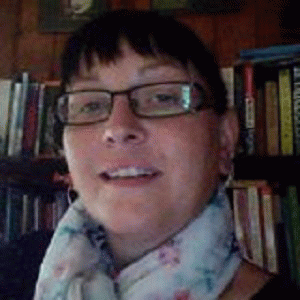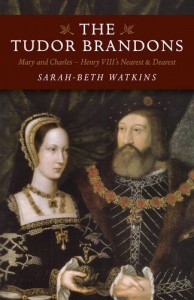Sarah-Beth Watkins is the author of ‘Lady Katherine Knollys: The Unacknowledged Daughter of King Henry VIII’ and ‘Ireland’s Suffragettes: The Women Who Fought for the Vote.’
Her new book, ‘The Tudor Brandons: Mary and Charles – Henry VIII’s Nearest & Dearest’ was published earlier this month in the UK and USA.
To buy in the UK:
To buy in the USA:
Follow Sarah-Beth Watkins on Social Media:
Twitter: @SarahBWatkins
Facebook: Sarah-Beth Watkins
Many thanks to Sarah for answering my questions.
Why did you choose to write about the Tudor Brandons?
The simple answer is I just love Tudor history. There are other periods I’m also interested in but when I open a new book about the Tudors it feels like I’m coming home! Yet you rarely get books on the other people that featured at Henry VIII’s court. There are so many books on the king and his wives that I’m really driven to write about alternative people that were there and lived their lives around him. Charles has always fascinated me as being the closest to the king and unlike others never lost his head. Mary did as she was told and married the King of France but then married Charles without Henry’s express permission and although he fined them for it, his displeasure with the both of them didn’t last. I think they were the closest Henry had to friends and family.
What does your book add to existing works about Mary Tudor and Charles Brandon?
I hope that the book gives more of a rounded view of their relationship and more information on Charles as a man. Charles had an appalling track record with women so I wondered why Mary would be so infatuated with him. She knew of his previous marriages and his heritage and yet she still loved him and saw him as a way out of her situation in France. I found researching Charles’ family fascinating and think it added to his portrayal. Also whilst there are books about Mary, there is little about her later life or her descendants and I hope this will add to our knowledge about this couple.
Who do you think was the main protagonist behind their marriage, Mary or Charles?
Mary definitely! She had to marry Louis XII who was no prize, aging and unwell and after his death she was hounded by his successor, Francis I. I think she had always admired Charles and whilst away from Henry’s strict instructions, she had the chance to marry someone she had grown up with and loved. She wouldn’t have had the chance back in England. I’m sure Henry would have used her again to his political advantage.
Why do you think Henry VIII forgave Mary for marrying Charles?
Mary was the last of his immediate family to be close to him. His elder sister Margaret was causing him a headache as Queen of Scotland. She was feisty and wilful and although Mary also showed these traits, he had a soft spot for her. She was his baby sister and I think he always knew she was in love with Charles. Her choice of husband was also his best friend so I think he was happy to have them back at court, to have people he could trust by his side and still to some degree control.
What evidence is there that Charles wrote the verse that was added to their marriage portrait?
To be honest, the poem is attributed to him as something he wrote to add to the portrait but also to appease Henry after they returned home but we shall never really know for sure.
Why do you think that Charles survived to almost the end of Henry’s reign, when other courtiers didn’t?
Two reasons mainly. One – they grew up together. When Henry was an impressionable young boy he looked up to Charles who taught him how to joust and gave him respite from his stuffy school room lessons. He was a chivalrous (sort of!) knight and Henry wanted to be just like him. I think their relationship was solid because it went back so far and two, Charles survived because he did as he was told! Ok, so he married Mary but I’m sure this had been discussed as a possibility with the king prior to his trip to France as per Henry’s instruction for him not to act on his feelings when he was there. Henry was well aware of the couple’s feelings for each other. So apart from this Charles never really went up against his king. Even if Charles was unhappy at a situation – for instance, over Anne Boleyn – he still carried out Henry’s wishes.
Do you think Edward VI or John Dudley was the instigator of the ‘Devise for the Succession’?
This is a tricky one and something I think will be debated for many years to come. Edward has often been portrayed as a sickly king and one who was controlled by others but I think he was far stronger than that. The devise is in his own writing not something he just signed and I think he thought long and hard about what he was going to do with the succession. Mary and Elizabeth had been declared illegitimate but Mary was also a Catholic and had caused Edward constant trouble so we can see why she would not be included. Elizabeth is a different matter but then if he had to leave out one illegitimate sister then he had to leave out the other really. Of course Dudley was always in the background advising Edward but I think the king was far more astute than he is given credit for.
The description you give of Queen Jane is based on the only contemporary account by Baptista Spinola. In the paperback version of her book ‘The Sisters Who Would Be Queen’ (published 2010); Leanda de Lisle argues that the letter and description are a fake. Do you have an opinion about this?
I had no reason to disbelieve the short description of Jane’s personal appearance as it has been quoted in many academic texts since 1906 and I felt it was reasonably near the truth. Yet Lisle and Edwards have pointed out now that Spinola’s full letter only appeared in Davey’s work of 1906 and never before and they have examined it for its inconsistencies. They make a good case for it being a work of fiction and perhaps now if quoted it should be mentioned as such.



































